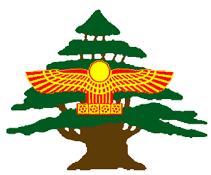 ARAMEAN
HISTORY
ARAMEAN
HISTORY
THE
Arameans
The Aramean people have lived at their traditional area in the Middle East
“Aramea” since three thousand years. The cultural contributions of the Arameans have had great significance thru the history. During the ancient
times the Arameans were known as prominent merchants and culture and
alphabet spreaders. They dominated the trade along the old “Silk
Road”. Their relatively easy language, the Aramaic, and its easy
alphabet with 22 letters were spread fast over great areas in Asia. Many
other languages were by this time written by the Aramaic alphabet. Most of
the world's alphabets today are originally derived from Aramaic alphabet
and its vowel system.
and its easy
alphabet with 22 letters were spread fast over great areas in Asia. Many
other languages were by this time written by the Aramaic alphabet. Most of
the world's alphabets today are originally derived from Aramaic alphabet
and its vowel system.
Since
4th century AD the Arameans have been without any state of their own.
During the breakdown of the Ottoman Empire, after the First World War, the
victorious states established a new order in the Middle East. The colonial
powers France and Great Britain divided the area of the Middle East
without any respect to the ethnic groups. They drew a new map over the
area and created new countries like
Turkey,
Syria, Iraq, Lebanon, Jordan etc. The
new borders they drew didn’t take any consideration to the “national
states”. On the contrary the borders were drawn across ethnic groups
rather than between them. The modern borders of the Middle East have
divided “Aramea” and split the Arameans, who today live under hard
conditions in these countries. A Syriac-Aramaic delegation was sent to the
conference in Sèvres 1920 with the hope to regain the historical rights
in areas that by history were Aramaic. But the super powers refused the
Arameans these rights. Since the foundation of the new states in the
Middle East, all the regimes try to force the Arameans to abandon their
culture, language and ethnic belonging. The Arabizing and Turkizing
attempts continue among them on a high level. For example thousands of
Aramaic names of villages, fields, rivers and areas have been changed into
Turkish and Arabic names.
THE
SYRIACS/ARAMEANS HAD AN OLDER NAME
The
Syriacs were earlier called Aramean and their language Aramaic. The oldest
preserved documents where the name Aram is mentioned is dated to 2300 BC.
The Greeks were probably the first ones who named the Arameans by the
Syrian name in the 5th century BC. The famous Greek geographer and
historian Strabo (dead 23 AD)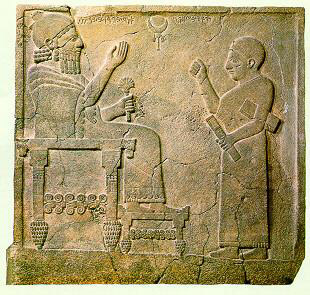 says in his book “Geography”: “Those
who call themselves Arameans, we call them Syrians”.Even in the “Septuagint”,
the old translation of the Old Testament into Greek achieved in the 3rd
century B.C., the name Aram was translated into Syria, Aramean into
Syrian, and Aramaic into Syriac. The Arameans continued to call themselves
Aramean. But gradually they started to use the Greek term Syriac/Syrian as
a synonymous to the appellation Aramean, and Syriac as a synonymous to
Aramaic. During the first century A.D. most of the Arameans were
convereted to Christianity. During that period they called themselves
Syrian-Arameans.During the time the term "Syriac/Syrian" took
bigger place and the Aramaic term was left in the shadow. But authors
still used the double term Syriac/Aramaic as synonymous for the same
people and language. All the ancient Syriac historians that searched in
the history of the Syriacs mentions that the Syrians earlier were called
Arameans and their language Aramaic. So when we want to do some research
about early history about Syrians we have to search under the term Aramean.
In the following chapters we are using the terms Aramean, Syriac and
Syrian for the same people.
says in his book “Geography”: “Those
who call themselves Arameans, we call them Syrians”.Even in the “Septuagint”,
the old translation of the Old Testament into Greek achieved in the 3rd
century B.C., the name Aram was translated into Syria, Aramean into
Syrian, and Aramaic into Syriac. The Arameans continued to call themselves
Aramean. But gradually they started to use the Greek term Syriac/Syrian as
a synonymous to the appellation Aramean, and Syriac as a synonymous to
Aramaic. During the first century A.D. most of the Arameans were
convereted to Christianity. During that period they called themselves
Syrian-Arameans.During the time the term "Syriac/Syrian" took
bigger place and the Aramaic term was left in the shadow. But authors
still used the double term Syriac/Aramaic as synonymous for the same
people and language. All the ancient Syriac historians that searched in
the history of the Syriacs mentions that the Syrians earlier were called
Arameans and their language Aramaic. So when we want to do some research
about early history about Syrians we have to search under the term Aramean.
In the following chapters we are using the terms Aramean, Syriac and
Syrian for the same people.
THE
ARAMEANS
The
old Syriacs, the Arameans, had a city-state system. From the 13th century
B.C. onwards they had tens of states spread over a big area that today
consists of Syria, Lebanon, north of Israel and north of Jordan, Iraq and
the whole area of south Turkey. This area is today called
"Fertile
Crescent", but we can call it "Aramea". Most of the Aramean
states had their own proper local names with the addition of the name Aram,
like Aram-Soba(in Libanon,) Aram-Damascus,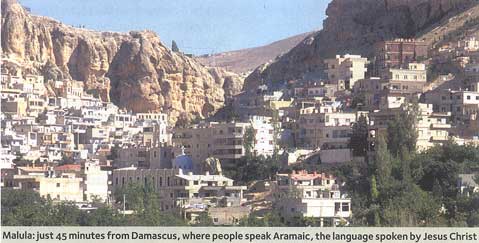 Aram-Maaka, etc., or carried
the addition "Beth" like Beth Adini, Beth Zamani, Beth Bakhiani,
etc. After the Assyrian state breakdown in the year 612 B.C. at the hands
of the the Babylonian Arameans and their allies the Medes, The Arameans of
Babylon established a big empire, that is known under as the second
Babylonian state, or the New Babylonian Epire, and the "Chaldean"
state, named after the Aramean tribe Kaldu which was originally settled
around the Persian Gulf and then moved to Babel and Aramacized it. Known
from this state is King Nebuchadnessar who set the Palestinian Jews in
exile in Babylon. But this powerful state couldn’t continue to live
through any longer time. It was captured by the Persians in 539 B.C. In
the Old Testament there is a lot to read about the Jews relation to the
Arameans. Even the Jews were Arameans, especially during their early
history. The great patriarchs Abraham, Isaac and Jacob were Arameans (In
the Deuteronomy book 26:5 it says: "My
ancestor was a wandering
Aramean). But after departure from Egypt and during the influence of
closely allied people like Canaanites and Hettites and because of the
conflicts with the Aramean ancestors, the Israelites became a special
national group and their Aramaic language was changed into Canaanite.
Aram-Maaka, etc., or carried
the addition "Beth" like Beth Adini, Beth Zamani, Beth Bakhiani,
etc. After the Assyrian state breakdown in the year 612 B.C. at the hands
of the the Babylonian Arameans and their allies the Medes, The Arameans of
Babylon established a big empire, that is known under as the second
Babylonian state, or the New Babylonian Epire, and the "Chaldean"
state, named after the Aramean tribe Kaldu which was originally settled
around the Persian Gulf and then moved to Babel and Aramacized it. Known
from this state is King Nebuchadnessar who set the Palestinian Jews in
exile in Babylon. But this powerful state couldn’t continue to live
through any longer time. It was captured by the Persians in 539 B.C. In
the Old Testament there is a lot to read about the Jews relation to the
Arameans. Even the Jews were Arameans, especially during their early
history. The great patriarchs Abraham, Isaac and Jacob were Arameans (In
the Deuteronomy book 26:5 it says: "My
ancestor was a wandering
Aramean). But after departure from Egypt and during the influence of
closely allied people like Canaanites and Hettites and because of the
conflicts with the Aramean ancestors, the Israelites became a special
national group and their Aramaic language was changed into Canaanite.
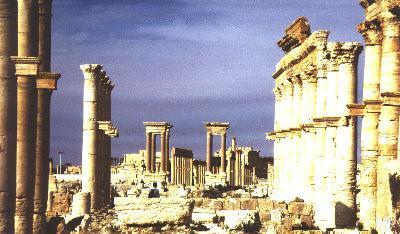
During
200-100 B.C. the Arameans reestablished several Aramean national states.
They didn`t survive for a long time because they lost their independence
in the 3rd century A.D. Among the Aramean states in this period we mention
the Nabataen and its capitol Petra (in Jordan) Damascus, Emesa, Palmyra
(in Syria), Hatra, Singara (in Iraq), Edessa, Malatya, and Amed (in Turkey).
Thereafter and until today the Arameans have been ruled by other people
like Romans, Persians, Arabs, Mongols, Turks etc.

THE ARAMEANS
AND CHRISTIANITY
According
to the early Christian traditions the Aramean King Abgar V Ukomo (the
black) of Edessa (Urhoy) was Christianized already during the lifetime of
Jesus Christ. King Abgar suffered from leprosy and his doctor couldn’t
cure him. He had heard of a certain wise man (Jesus) in
Palestine and that
this man had effective remedy for illness. He sent a delegation with a
letter to Jesus and invited him to Edessa to cure King Abgar. Jesus
responded the request and wrote that he couldn’t attend to Edessa
because he had other missions. But he sent one of his followers, Taddeus,
who cured King Abgar and this was followed by the Kings conversion to
Christianity. His state Edessa became later famous for this event and for
the possession of the mentioned letters that were exchanged between Abgar
and Jesus. Visitors from almost all the Christian countries came to Edessa
to see the letters and to get a transcription of them. This is according
to Eusebius of Caesarea, who wrote about this in his church history in the
first half of the 4th century. Edessa later became an important centre for
Syriac Christian culture as well as the city of Antiochia became the
centre of the Greek speaking church.
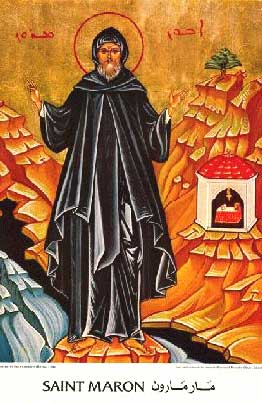
The
Aramaic dialect that was spoken in Edessa, which is called Syriac, became
the standard language in the young Aramean Christian church. In this
language thousands of books were written and it is this language
Syriac-Aramaic, that today is used in the teaching and in the churches
that use Syriac. The Christian Arameans missioned in a lot of countries;
India, Tibet, Mongolia and China. Many Central Asian ethnic groups like
Mongols and the Turks converted to Christianity and used the
Syriac-Aramaic liturgy. But after a few centuries they converted to Islam.
The name Syriac became thereafter totally connected to Christian Arameans.
In Kerala in southern India there are still Syrian churches with almost
10-12 million adherents who have Syriac-Aramaic as church language.In the
5th century the church was divided and the following Syriac-Aramean
churches arised:
1.
East-Syriac church, the Nestorian part. It was founded in the 5th
century with almost all eastern Christian Arameans as adherents (especially
in Iraq and Iran) it has since 1960s been divided in two parts each with
its own patriarch, one in USA and the other in Iraq.
2.
The Syriac church in west. All the Christian Arameans west of the
Euphrates were adherents to this church. The western church was divided in
the year of 451 A.D. into two parts: 2a Syriac orthodox Church which
exists mostly in Syria, Lebanon and Iraq with its patriarch in Damascus.
2b Syriac
Orthodox "Rum", called also the Greek Orthodox, in Syria, Lebanon,
Jordan, Israel,
with its patriarch in Damascus.
3.
Syriac Maronite, 7th and 8th century (In Lebanon where the
patriarch has his seat, it’s the biggest among the Aramean churches).

4.
Eastern Syriac, Chaldean catholic part, 16th century (mostly in
Iraq with patriarch in Baghdad)
5.
Syriac Catholic, 17th – 18th century (Lebanon, Syria and Iraq
with patriarch in Beirut).
6.
Greek Catholic "Rum" 18th century (mostly in
Syria and Lebanon with patriarch in Damascus).
7.
Protestant churches, 19th century (mostly in Syria and Lebanon with
seat in both countries).
8.
Other small Christian groups, and other religious ethnic Aramean
groups like Mandeans in Iraq and Iran.
ARAMEANS DURING THE
MIDDLE AGES
In
the 7th century Islam was spread in the Aramean area “Aramea”.
According to Islamic law the society was divided into four groups. The
Christian Arameans became the third grade citizens and were forced to pay
double taxes to the state, while the Muslims were released from paying the
tax. Many Arameans were obliged to convert to Islam trough hard
perscutions and when they couldn`t pay the taxes. They were oppressed and
discriminated economically, socially, ethnically and culturally and they
were forced to convert to the new religion because they wanted to live
like free citizens. With the time passing the religious oppression and
persecution increased and the Syriac Christians conversion to Islam
increased a lot. Islam elevated Arabic to a divine language and it become
necessary for the citizens to learn Arabic. Many of the Arameans/Syriacs
adopted Arabic language and forgot their Aramaic/Syriac language as time
passed. Today a big part of the Aramean people speaks Arabic only while a
smaller amount of them can talk their Aramaic language in its modern
dialects. Until the end of the 13th century the Arameans were a majority
in “Aramea” (Middle East) but at the end if that century the area was
conquered by the Mongolian Timur Lenk. Big parts of the Aramean population
were obliterated and the ones that were left became a minority. During the
last 700 years the Arameans/Syriacs have been constantly victimised for
different religious massacres mostly executed by fundamentalistic Kurds
and Turks. The last large massacre took place 1915 when almost
300.000-500.000 Christian Arameans were killed in a brutal way in south
east of Turkey.
ARAMAIC
LANGUAGES
Aramaic
is one of the oldest language that still is used. It’s the only Semitic
language in the World that has been used verbally and in writing without
breaks for 3000 years. The oldest known Aramaic inscriptions are from the
10th century BC. In its long history you can split up Aramaic in five
phases:
1.
Old Aramaic, 925-700 BC. Here you can find the first found
inscriptions. It represents an archaic form of Aramaic.
2.
Official Aramaic, 700-200 BC. During this period the language had a
big geographical spread from Egypt, Arabia, Palestine, Syria and Bablon,
Assyria, Armenia, the Indus valley in Afghanistan and Pakistan.
3.
Middle Aramaic, 200 BC – 200 A.D.
4.
Late Aramaic, 200 – 1300 A.D., at this period the language had western
and eastern dialects, the latter in a further western and eastern dialects.
5.
Modern Aramaic from, this period covers all forms of Aramaic which
are spoken until these days.
At
the first century A.D. different Aramaic dialects were spoken in the area
called the Fertile Crescent. The Aramaic dialect which has been spoken
inside the Assyrian and Babylonian borders since the 700 century BC
superseded all other Aramaic dialects. In the end of the 7th century BC
the Aramaic was an international language among diplomacy, administration
and trading and continued in its Syriac form to be a cultural mean of
communication in the Middle East until 600 A.D.

When
the Persian Achaemeans, led by Cyrus in the year 539 B.C, conquered
Babylon and put an end to the Aramean Babylonian empire, they founded a
large Achaemenidic empire that stretched from the Indus valley in the
north to the Nile in the south. The Persians continued to use the Aramaic
as a written means of communication in their administration. Since Aramaic
already has been a lingua franca in the Babylonian Aramean Empire, the
Persians were obliged to take over the language in the whole state.
Aramaic was then the dominating spoken language in Mesopotamia and Syria.
When Alexander the Great conquered the whole area in 333 B.C. he made the
Greek into official language. The Persian parthians on the other hand that
established a big empire during the centuries around Christ’s birth
reinstalled Aramaic as the official language in their state. In the
beginning of our era Aramaic consisted of different dialectal forms, was
the dominated spoken language in Syria and Mesopotamia. The Aramaic
developed a number of literary dialects. The most famous are the western
parts: Palestinian-Jewish Aramaic, Samaritan, Syro-Palestinian Christian
Aramaic, all of them along the eastern border of the Mediterranean see and
further more the eastern parts: Babylonian Talmudic Aramaic, Mandaic, and
Syriac in Mesopotamia. The Syriac language was the Aramaic language that
was used in the Aramean states Edessa (Urfa) and Nisibis. Because of
political, social, cultural and churchly causes the language was spread on
the behalf of all other Aramaic dialects.